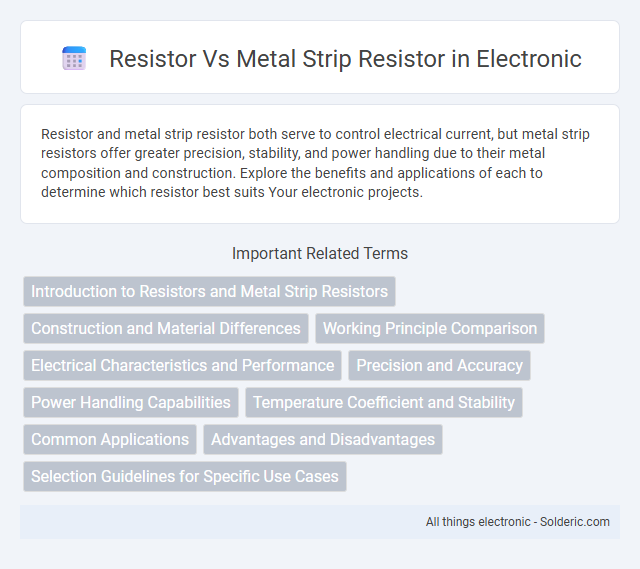Resistor and metal strip resistor both serve to control electrical current, but metal strip resistors offer greater precision, stability, and power handling due to their metal composition and construction. Explore the benefits and applications of each to determine which resistor best suits Your electronic projects.
Comparison Table
| Feature | Resistor | Metal Strip Resistor |
|---|---|---|
| Construction | Carbon film, metal oxide, wire-wound | Thin metal strip on ceramic substrate |
| Resistance Range | Ohms to Megaohms | Low to medium range, precise values |
| Tolerance | +-1% to +-20% | High precision, +-0.1% to +-1% |
| Power Rating | 0.1W to several watts | Typically 0.5W to 5W |
| Temperature Coefficient | Higher (100 to 500 ppm/degC) | Low (+-10 to +-50 ppm/degC) |
| Applications | General purpose circuits | Precision circuits, calibration, instrumentation |
| Cost | Low cost | Higher cost due to precision |
| Stability | Moderate | High long-term stability |
Introduction to Resistors and Metal Strip Resistors
Resistors are fundamental electrical components designed to limit current flow and adjust signal levels in electronic circuits, characterized by resistance measured in ohms. Metal strip resistors, a type of precision resistor, utilize a thin metal strip etched onto an insulating substrate, offering enhanced accuracy, stability, and power dissipation compared to traditional carbon or metal film resistors. Their precise resistance values and low temperature coefficient make metal strip resistors ideal for high-performance applications in instrumentation and industrial electronics.
Construction and Material Differences
Resistors typically consist of a carbon film or wire-wound element encased in a ceramic or plastic body, designed for general-purpose resistance with predictable performance. Metal strip resistors use a thin metal alloy strip etched or laser-trimmed on a ceramic substrate, offering higher precision, stability, and lower noise due to the uniformity of the metal film. The construction of metal strip resistors allows for better thermal conductivity and tolerance control compared to conventional carbon or wire-wound resistors.
Working Principle Comparison
Resistors operate by limiting electrical current through the material's resistance, converting electrical energy into heat based on Ohm's law. Metal strip resistors specifically use a thin metal strip with a precise geometry to achieve resistance, offering higher accuracy and stability compared to conventional resistors made from carbon or metal oxide. Your choice between these depends on required precision, thermal stability, and application-specific performance in circuits.
Electrical Characteristics and Performance
Resistors exhibit varying electrical characteristics and performance based on their construction, with metal strip resistors offering superior precision, lower noise, and better thermal stability compared to standard resistors. Metal strip resistors provide tighter tolerance values and enhanced power dissipation capabilities due to their robust metal alloy construction, making them ideal for high-frequency and high-power applications. Your choice between resistor types should consider these factors to ensure optimal circuit performance and reliability.
Precision and Accuracy
Metal strip resistors offer superior precision and accuracy compared to standard resistors due to their tightly controlled manufacturing process and minimal resistance tolerance, often within +-0.1%. These resistors maintain stable performance under varying temperatures and environmental conditions, ensuring consistent resistance values critical for high-precision applications. Your choice of resistor type significantly impacts the reliability and accuracy of sensitive electronic circuits.
Power Handling Capabilities
Metal strip resistors offer superior power handling capabilities compared to standard resistors due to their robust construction and efficient heat dissipation properties. Their metal substrate allows for higher wattage ratings, making them ideal for high-power applications and environments with thermal stress. When selecting a resistor for your circuit, choosing a metal strip resistor ensures enhanced reliability under demanding power conditions.
Temperature Coefficient and Stability
Metal strip resistors exhibit a lower temperature coefficient typically around +-5 ppm/degC, ensuring minimal resistance change with temperature fluctuations compared to standard carbon or metal film resistors, which often have coefficients ranging from +-50 to +-200 ppm/degC. This low temperature coefficient contributes to higher stability and precision in metal strip resistors, making them suitable for applications requiring long-term reliability and accuracy under varying thermal conditions. Their design and material choice significantly reduce drift and resistance variance, enhancing performance in sensitive electronic circuits.
Common Applications
Resistors are widely used in electronic circuits for current limiting, voltage division, and signal conditioning across various consumer electronics and industrial equipment. Metal strip resistors, known for their precision and stability, are commonly applied in high-frequency circuits, power supplies, and precision measurement devices where low noise and accurate resistance values are critical. Your choice between standard resistors and metal strip resistors depends on the application's requirements for tolerance, thermal stability, and power handling.
Advantages and Disadvantages
Resistors offer precise resistance values and are widely available in various types, with carbon film and metal oxide variants providing cost-effective solutions, but they can suffer from temperature sensitivity and noise. Metal strip resistors exhibit superior stability, low noise, and high precision due to their metal film construction, making them ideal for high-frequency and precision applications; however, they are generally more expensive and less robust under mechanical stress. Choosing between standard resistors and metal strip resistors depends on balancing performance requirements such as accuracy and thermal stability against cost and durability.
Selection Guidelines for Specific Use Cases
When selecting resistors for specific use cases, consider power rating, tolerance, and temperature stability; metal strip resistors typically offer higher precision and better thermal performance than standard resistors. Your choice should align with application requirements such as high-frequency circuits, where metal strip resistors excel due to low inductance. Evaluate factors like environmental conditions and mechanical stress to ensure optimal resistor selection and long-term reliability.
resistor vs metal strip resistor Infographic

 solderic.com
solderic.com